as seen from Sol.
Epsilon Indi.
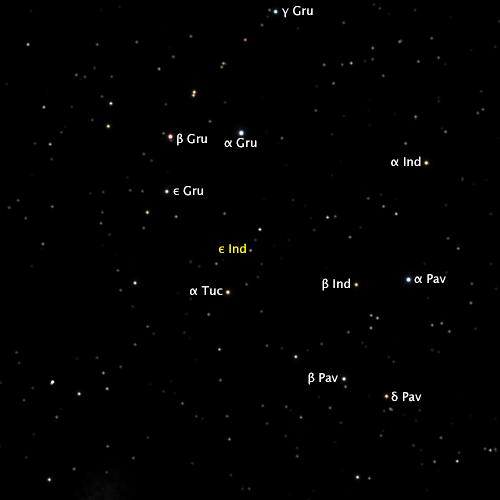
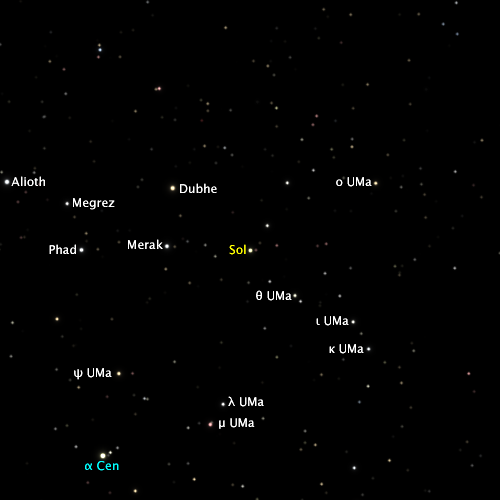
| Right Ascension | 22h 03m | ||
|---|---|---|---|
| Declination | −56° 47' | ||
| Distance | 11.82 ± 0.03 ly | ||
| Star | Epsilon Indi A | Epsilon Indi B | Epsilon Indi C |
| Spectral Class | K5V | L8.5V | T4V |
| Estimated Mass | 0.67 × Sol | 0.03 × Sol | 0.02 × Sol |
| Luminosity | 0.262 × Sol | 0.000030 × Sol | 0.000013 × Sol |
| Notes | Brown dwarf | Brown dwarf | |
| Epsilon Indi as seen from Sol. |
Sol as seen from Epsilon Indi. |
|---|---|
 |
 |
| Star | Magnitude | Distance |
|---|---|---|
| Canopus | −0.65 | 303.7 |
| Sirius | −0.18 | 15.3 |
| Fomalhaut | 0.16 | 15.8 |
| Rigel | 0.18 | 863.5 |
| Achernar | 0.29 | 129.2 |
| Arcturus | 0.34 | 43.9 |
| Vega | 0.44 | 30.3 |
| Betelgeuse | 0.47 | 502.4 |
| Alpha Aurigae (Capella) | 0.50 | 52.0 |
| Beta Centauri (Hadar) | 0.57 | 385.1 |
| Alpha Crucis (Acrux) | 0.73 | 315.7 |
| Altair | 0.81 | 17.1 |
| Spica | 1.00 | 252.1 |
Epsilon Indi is an orange dwarf star of spectral type K5V that is located 11.82 light years from Sol.
From Epsilon Indi, Sol appears near the Big Dipper and shines with a similar brightness to the other seven stars in that asterism.
| Destination | Distance |
|---|---|
| 61 Cygni A | 17.3 |
| Beta Hydri | 14.3 |
| Gliese 682 | 11.0 |
| Gliese 832 | 4.8 |
| Sol | 11.8 |
The system was explored with probes from the Dandelion Project in 2593. The probes found a system of seven planets and two brown dwarf companions. Two of the planets, Cyania and Azuria, are a binary pair of gas giants that are tidally locked to each other, and were the first such binary gas giants discovered.
The planet Aridia was originally a desert world without any water or life. It was terraformed and colonised and is home to the colony of the Aridia Corporation.
| Planet | SMA (AU) |
Orbital Period |
e | Equatorial Diameter (km) |
Mass (Earths) |
Density (g/cm3) |
Gravity (Earth g) |
Atmospheric Pressure (Earth=1) |
Sidereal Day |
Mean Solar Day |
Axial Tilt |
Known Moons |
|---|---|---|---|---|---|---|---|---|---|---|---|---|
| Celeria | 0.2809 | 66.425 d | 0.0053 | 2911 | 0.01010 | 4.67 | 0.1939 | 0.0 | 66d 10h 12.2m | Synchronous | 00° 20.1' | 0 |
| Aridia | 0.5694 | 191.71 d | 0.0056 | 11620 | 0.6569 | 4.78 | 0.7905 | 1.13 | 1d 03h 39.3m | 1d 03h 49.4m | 01° 37.5' | 0 |
| Flavus | 0.9903 | 1.2040 y | 0.0377 | 5771 | 0.07745 | 4.60 | 0.3782 | 0.0753 | 1d 13h 21.9m | 1d 13h 29.9m | 24° 08.3' | 0 |
| Rubicunda | 4.654 | 12.266 y | 0.0267 | 106600 | 119.8 | 1.19 | 1.714 | &mdash | 13h 19.5m | 13h 19.6m | 06° 57.5' | 13 |
| Cyania | 9.249 | 34.366 y | 0.0946 | 97110 | 113.7 | 1.47 | 1.961 | — | 22h 49.5m | 22h 49.6m | 14° 24.4' | 6 |
| Azuria | 58890 | 22.74 | 1.33 | 1.067 | — | 22h 49.5m | 22h 49.6m | 14° 22.7' | ||||
| Tardia | 18.64 | 98.320 y | 0.1914 | 59060 | 22.27 | 1.24 | 1.038 | &mdash | 1d 14h 19.8m | 1d 14h 19.9m | 41° 24.9' | 11 |
| Name | Diameter (km) |
Period (days) |
Semimajor Axis (km) |
Ecc | Inc |
|---|---|---|---|---|---|
| Natural Satellites of Rubicunda | |||||
| Rubicunda XII | 10 | 0.2609 | 85030 | 0.0000 | 0.00 |
| Rubicunda XIII | 9 | 0.2666 | 86260 | 0.0002 | 0.00 |
| Rubicunda IV | 171 | 0.5896 | 146400 | 0.0002 | 0.24 |
| Rubicunda V | 286 | 1.066 | 217300 | 0.0032 | 0.95 |
| Rubicunda I | 2706 | 2.582 | 392000 | 0.0011 | 1.63 |
| Rubicunda VI | 149 | 2.582 | 392000 | 0.0314 | 1.63 |
| Rubicunda II | 5909 | 4.724 | 586200 | 0.0002 | 0.33 |
| Rubicunda VII | 289 | 4.724 | 586200 | 0.0163 | 0.35 |
| Rubicunda VIII | 159 | 4.724 | 586200 | 0.0356 | 0.44 |
| Rubicunda III | 2589 | 9.951 | 963400 | 0.0017 | 1.11 |
| Rubicunda IX | 427 | 22.43 | 1656000 | 0.0235 | 3.99 |
| Rubicunda X | 312 | 48.93 | 2786000 | 0.0635 | 9.00 |
| Rubicunda XI | 189 | 84.71 | 4017000 | 0.1921 | 156.99 |
| Natural Satellites of Cyania-Azuria | |||||
| Cyania I | 1910 | 9.315 | 940100 | 0.0132 | 1.00 |
| Cyania II | 512 | 18.62 | 1492000 | 0.0144 | 0.39 |
| Cyania V | 157 | 27.98 | 1957000 | 0.0215 | 1.65 |
| Cyania III | 2528 | 37.30 | 2371000 | 0.0048 | 0.20 |
| Cyania IV | 627 | 89.00 | 4233000 | 0.0432 | 1.22 |
| Cyania VI | 93 | 326.6 | 10070000 | 0.3647 | 84.68 |
| Natural Satellites of Tardia | |||||
| Tardia VI | 427 | 0.9532 | 115100 | 0.0015 | 0.56 |
| Tardia I | 1903 | 1.759 | 173200 | 0.0038 | 1.36 |
| Tardia II | 1804 | 3.532 | 275600 | 0.0012 | 1.31 |
| Tardia III | 4260 | 6.989 | 434500 | 0.0001 | 1.42 |
| Tardia VIII | 170 | 6.989 | 434500 | 0.0003 | 1.26 |
| Tardia IV | 2202 | 14.82 | 717000 | 0.0127 | 1.62 |
| Tardia IX | 210 | 14.82 | 717000 | 0.0152 | 1.65 |
| Tardia V | 1015 | 24.30 | 997000 | 0.0122 | 1.32 |
| Tardia VII | 208 | 51.43 | 1644000 | 0.1680 | 0.43 |
| Tardia XI | 88 | 234.6 | 4521000 | 0.3844 | 49.66 |
| Tardia X | 73 | 241.0 | 4603000 | 0.6321 | 143.26 |
Celeria is a small, dense world, typical of the Hermian type. Like many worlds of its type it is heavily cratered and lacks an appreciable atmosphere. What little atmosphere it possesses is a very attenuated, temporary atmosphere consisting primarily of hydrogen and helium that is constantly replenished and blown away by the stellar wind.
When it was first discovered, Aridia was an Earth-size desert world in the habitable zone of its star with an atmosphere primarily composed of carbon dioxide and nitrogen. The world had only the barest trace of water in its atmosphere, and none on the surface. This surprising discovery was not predicted by the then-current theories of planetary formation, and many theories were proposed to explain this unusual world.
The reason for the lack of water on Aridia is still a matter of some debate among scientists.
A more important issue was whether the world should be terraformed. Proponents argued that the world was ideal for terraforming because it lacked life. Opponents argued that the reason for the lack of water was still unknown, and therefore represented a potential hazard to future colonists. Eventually the world was approved for terraforming, and terraforming commenced in 2619. Most of the terraforming involved the controlled deflection of comets into Aridia, which provided water and organic compounds for the formation of the future biosphere. The terraforming was completed by 2755, and the world was settled in 2760. Aridia has been transformed from a dessicated desert into a pleasant Earthlike world.
Aridia has a slight axial tilt of about 1.6 degrees, or about seven per cent that of Earth. The slight axial tilt causes the seasons on Aridia to be almost nonexistent, with the greatest seasonal temperature variation being only a few degrees Celsius. The seasons also cause the main rainfall belts to be mostly stationary and this causes the desert regions on Aridia to be relatively large compared to the deserts of Earth. The axial tilt also causes the day length to vary relatively little over the course of a year. At a high latitude of 72 degrees, the day length on Aridia varies by the equivalent of one Earth hour over the course of a year, whereas a similar latitude on Earth experiences the midnight sun for about ten weeks a year.
Flavus is a small Erebian world. Such worlds have more geological history than Selenian worlds, but like the Selenian world all geological activity has ceased. Flavus has a very thin atmosphere.
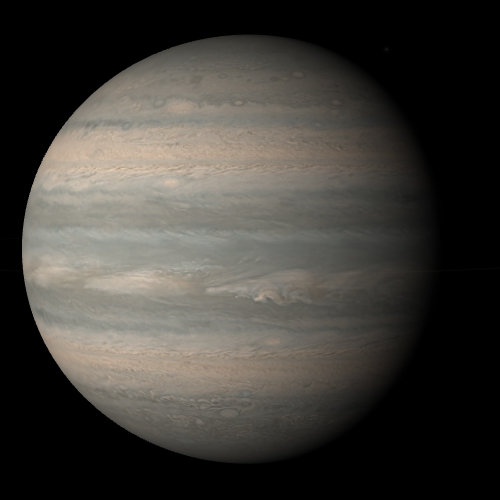 |
Rubicunda is an EuJovian gas giant with a mass larger than that of Saturn. Its dynamic weather systems give it belts and zones similar to those of Jupiter and other similar large planets with active weather. It has a very faint ring and a large retinue of satellites.
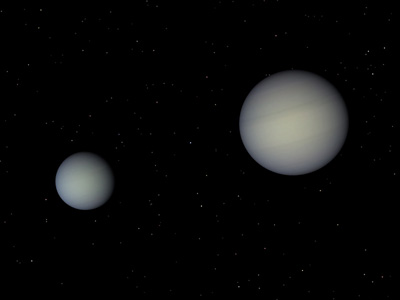
|
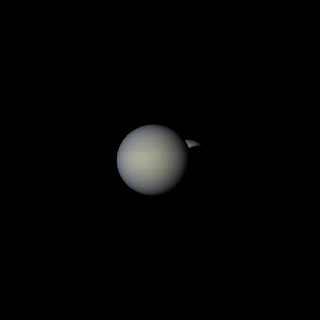
|
Cyania and Azura are the first binary gas giant discovered. Both worlds are CryoJovian worlds. They orbit each other in a tight orbit, revolving around their common centre of mass in about 23 hours. The worlds have six known satellites.
The larger world, Cyania, has prominent bands near its equator. Azuria also has bands but these bands are less prominent.
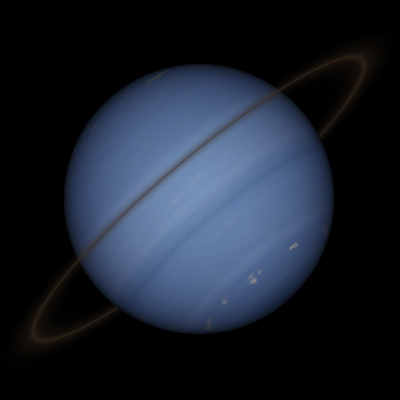 |
Tardia is another CryoJovian world in the Epsilon Indi system. It has a somewhat eccentric orbit, a large axial tilt, a prominent dusty ring and eleven known satellites.